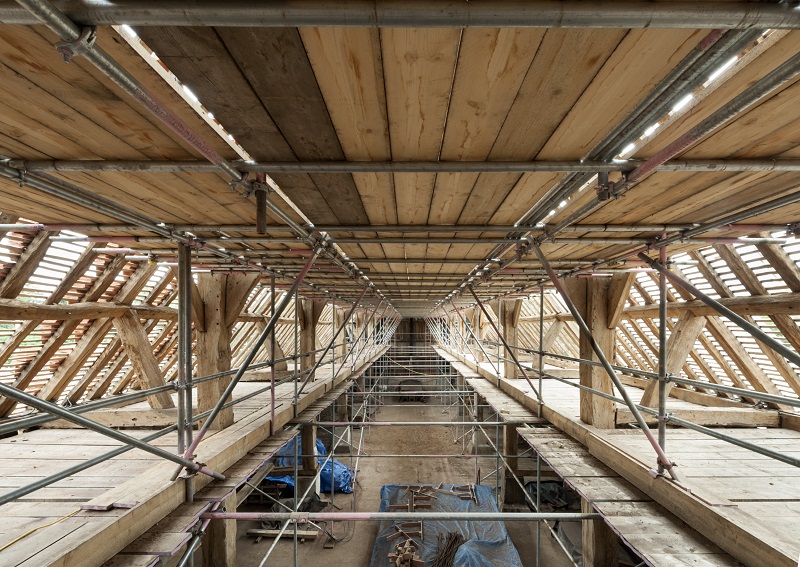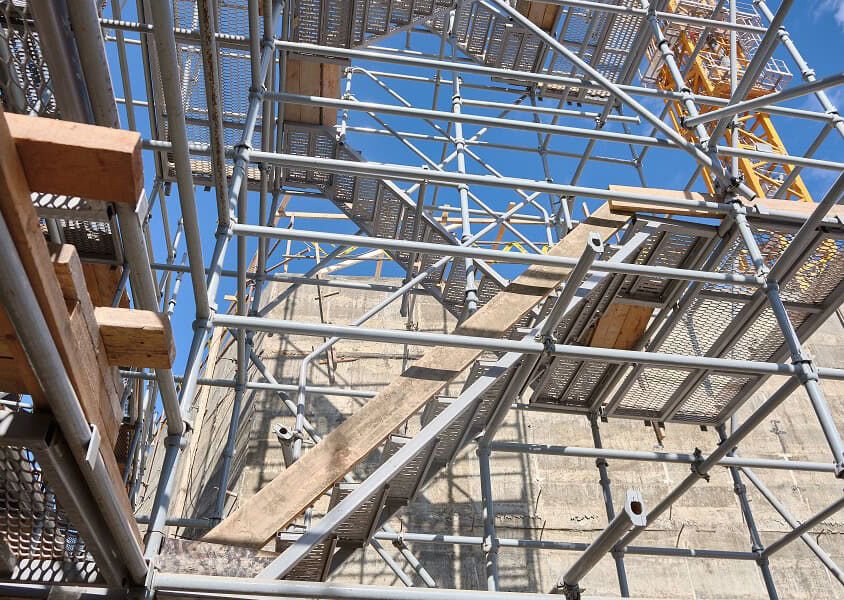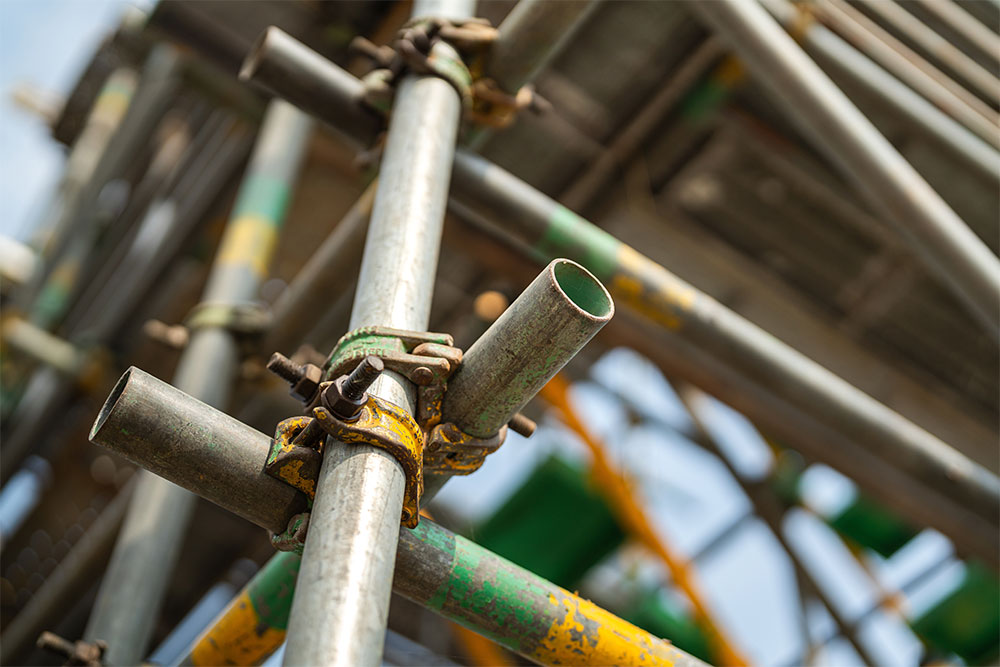Temporary Roof Scaffolding to Ensure Safe Working Conditions During Projects
Temporary Roof Scaffolding to Ensure Safe Working Conditions During Projects
Blog Article
Discovering the Numerous Kinds Of Scaffolding Made Use Of in Building Jobs
The building market counts heavily on numerous types of scaffolding to satisfy details task needs, each offering unique advantages and applications. Traditional framework scaffolding provides a tough structure for general tasks, while put on hold scaffolding is necessary for work on skyscraper frameworks.

Conventional Structure Scaffolding
Traditional framework scaffolding is among the most widely used methods in the building sector as a result of its robustness and convenience. This system includes straight and vertical frames that are put together to produce a secure system for materials and employees. The primary parts consist of vertical blog posts, horizontal ledgers, and angled dental braces, which together supply a solid framework that can support considerable loads.
One of the essential benefits of traditional frame scaffolding is its flexibility to various construction jobs, varying from household structures to huge business structures. The modular style enables very easy setting up and disassembly, making it effective for both long-term and temporary projects. In addition, the system can be personalized in elevation and size, fitting different building designs and website problems.
Safety and security is paramount in scaffolding applications, and typical frame systems are furnished with guardrails and toe boards to avoid drops and make certain worker security. In addition, regular examinations and adherence to safety and security laws are crucial in maintaining the stability of the scaffold. Generally, typical framework scaffolding remains a basic selection in the building industry, supplying a trusted system for labor and boosting total task performance

Suspended Scaffolding
Put on hold scaffolding provides an one-of-a-kind remedy for building and construction projects that call for access to raised surfaces, especially in situations where standard framework scaffolding may be unwise. This kind of scaffolding is normally put on hold from the roof covering or top levels of a structure, making use of a system of ropes, sheaves, and systems to create a working space that can be adapted to various heights.
One of the primary advantages of put on hold scaffolding is its flexibility. It can be conveniently rearranged or reduced to suit adjustments in construction needs, making it ideal for tasks such as home window installation, façade work, and maintenance on skyscraper structures. In addition, the very little footprint of suspended scaffolding enables much better use ground area in metropolitan atmospheres, where room is frequently minimal.
Security is a vital factor to consider in the usage of put on hold scaffolding. In general, put on hold scaffolding gives a effective and reliable option for accessing hard-to-reach areas in numerous construction circumstances, enhancing both productivity and security on site.
System Scaffolding
System scaffolding, commonly concerned as a contemporary remedy in the scaffolding market, contains pre-engineered elements that can be promptly constructed and adapted for various construction tasks. Scaffolding. This kind of scaffolding is identified by its modular layout, which permits convenience and efficiency on task sites, suiting architectural requirements and various elevations
Commonly made from high-strength steel or light weight aluminum, system scaffolding supplies improved longevity and stability. The elements include upright posts, horizontal journals, and angled braces, which adjoin safely, making certain a try these out robust framework. The style typically integrates standardized fittings, simplifying assembly and disassembly procedures, thus decreasing labor time and prices.

Rolling Scaffolding
Moving scaffolding is a versatile option to standard set scaffolding, designed for flexibility and convenience of usage on construction websites. This kind of scaffolding contains a platform sustained by frameworks with wheels, permitting employees to conveniently move it as needed. The wheelchair feature considerably improves productivity, as it lessens downtime connected with disassembling and putting together fixed scaffolding.
Commonly constructed from light-weight materials such as aluminum or steel, rolling scaffolding provides a tough yet mobile remedy for jobs needing constant repositioning - Scaffolding. It is specifically beneficial in tasks such as painting, drywall installation, and electric job, where access to various heights and areas is necessary
Safety is extremely important in rolling scaffolding layout, with features such as locking wheels to stop unplanned activity when in operation, and guardrails to secure employees from drops. Additionally, lots of designs are flexible in elevation, fitting different project needs.
Cantilever Scaffolding

The design of cantilever scaffolding usually includes utilizing braces or arms anchored to a structure or framework, allowing the platform to extend exterior securely. Security is extremely important; therefore, these scaffolds need to be engineered to stand up to environmental conditions and numerous loads. Normal assessment and maintenance are vital to guarantee architectural honesty and worker security.
Cantilever scaffolding is favored for its versatility and reliable use room, making it a preferred selection in metropolitan atmospheres where room constraints are common. Additionally, it promotes easier access to high altitudes, inevitably adding to the total efficiency of building and construction jobs. Just like all scaffolding types, appropriate training and adherence to security requirements are essential for workers using cantilever scaffolding.
Verdict
In verdict, the diverse kinds of scaffolding utilized in building and construction tasks each serve distinctive functions tailored to details site needs. Standard structure scaffolding offers browse around this web-site security, while put on hold scaffolding provides flexibility for raised jobs. System scaffolding promotes Web Site quick setting up, and rolling scaffolding improves mobility for differing workplace. Cantilever scaffolding properly deals with obstacles in metropolitan settings. Recognizing these scaffolding kinds is crucial for optimizing safety and productivity in construction, ultimately adding to the successful conclusion of tasks.
Traditional frame scaffolding provides a sturdy foundation for general tasks, while suspended scaffolding is necessary for work on high-rise frameworks.Rolling scaffolding is a flexible option to typical fixed scaffolding, developed for flexibility and simplicity of use on building websites. As with all scaffolding kinds, correct training and adherence to safety and security criteria are critical for workers using cantilever scaffolding.
Typical structure scaffolding gives stability, while put on hold scaffolding offers versatility for elevated tasks. System scaffolding assists in quick setting up, and rolling scaffolding enhances flexibility for varying work environments.
Report this page